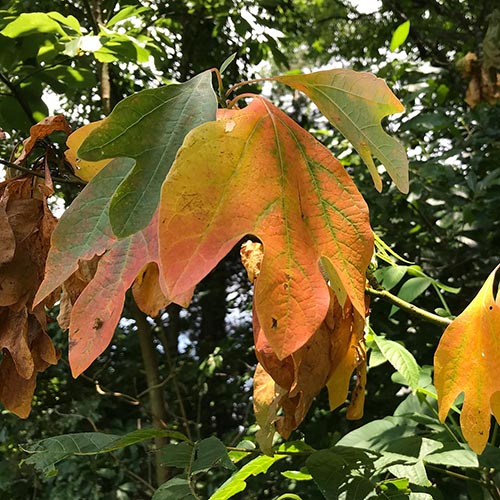
Listen to this Episode:
- From this webpage:
- Find the media player located under the episode picture.
- Click on the green triangle to listen to the audio for this episode.
- From your favorite podcast listening platform:
- Search for “Backyard Ecology.”
Show notes:
Laurel wilt disease is a disease caused by an introduced beetle and fungus. This disease is deadly to members of the Laurel family which includes redbay, sassafras, and spicebush. Laurel wilt disease also kills avocados, which aren’t native to the eastern U.S., but are in the Laurel family and are an important agricultural crop. As of spring 2021, laurel wilt disease has been found in 11 states in the eastern U.S. with the potential to spread to much further – even down into Mexico and Central America.
In this episode of the Backyard Ecology podcast, we talk with Alexandra Blevins about laurel wilt disease. Alexandra is the Forest Health Specialist with the Kentucky Division of Forestry and has been monitoring laurel wilt disease in Kentucky. This isn’t a topic that any of us really want to discuss, but it is an important one and one that we all need to be aware of.
In our conversation, Alexandra and I discuss the relationship between the redbay ambrosia beetle and the fungus that it carries. It is the fungus that causes laurel wilt disease. We also discuss how the disease kills the trees, what to look for in order to know if your trees have been infected, and what to do if you think you’ve found it. In addition, Alexandra shares with us some of the current research related to laurel wilt disease treatment and management. Unfortunately, as of this recording, there are no approved treatment options or “cures” for laurel wilt disease in sassafras and spicebush.
As much as this could be a complete doom and gloom story, there is also a small ray of potential hope. The primary way that laurel wilt disease is spreading is from humans moving wood products which contain the beetle larva and the fungus. If we are the primary cause of the spread of the disease, then we also hold the key to stopping it, or at least greatly slowing its spread. One of the primary ways that we can keep from spreading the disease is to not move wood products such as firewood, smoking / grilling wood, uncured lumber, etc. Not only will that reduce the risk of spreading laurel wilt disease, but it will also reduce the risk of spreading lots of other introduced diseases and pests.
Links:
- National / Regional resources
- Southern Regional Extension Forestry
- Alabama-based resources
- Arkansas-based resources
- Florida-based resources
- Georgia-based resources
- Kentucky-based resources
- Kentucky Division of Forestry Forest Health Program
- University of Kentucky Cooperative Extension Offices
- University of Kentucky Forestry Extension and Information on Laurel Wilt Disease
- Alexandra’s contact information
- Email: alexandra.blevins@ky.gov
- Phone: (502) 382-1720
- Mississippi-based resources
- North Carolina-based resources
- Tennessee-based resources
- Texas-based resources
- Backyard Ecology’s website
- My email: shannon@backyardecology.net
Episode image:
- Tell-tale signs of laurel wilt disease in a sassafras tree
- Photo credit: Alexandra Blevins, all rights reserved

Backyard Ecology: Exploring Nature in Your Backyard
Nature isn’t just “out there.” It’s all around us, including right outside our doors. Hi, my name is Shannon Trimboli, and I am the host of Backyard Ecology. I live in southcentral Kentucky and am a wildlife biologist, educator, author, beekeeper, and owner of a nursery specializing in plants for pollinators and wildlife conservation. I invite you to join me as we ignite our curiosity and natural wonder, explore our yards and communities, and improve our local pollinator and wildlife habitat. Learn more or subscribe to my email list at www.backyardecology.net.

Leave a Reply